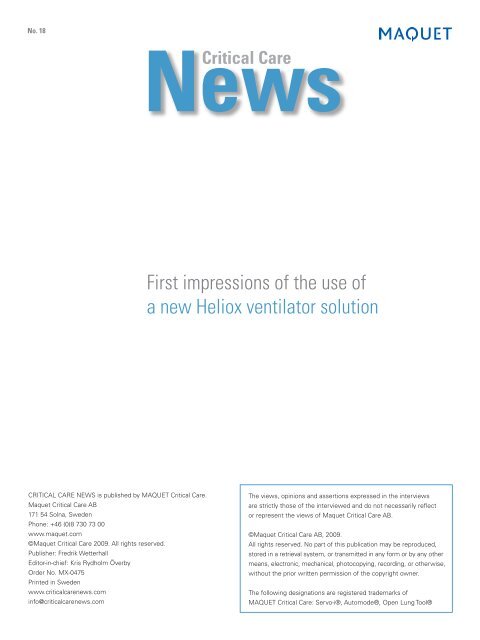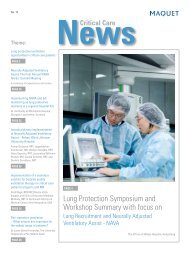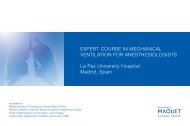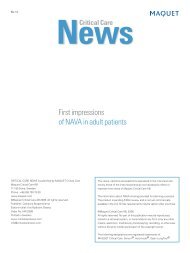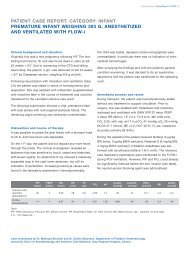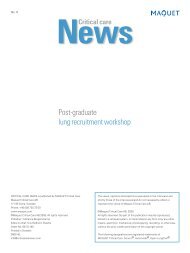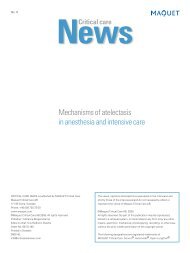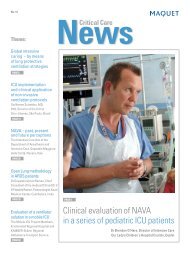First impressions of the use of a new Heliox ventilator solution
First impressions of the use of a new Heliox ventilator solution
First impressions of the use of a new Heliox ventilator solution
Create successful ePaper yourself
Turn your PDF publications into a flip-book with our unique Google optimized e-Paper software.
No. 18<br />
<strong>First</strong> <strong>impressions</strong> <strong>of</strong> <strong>the</strong> <strong>use</strong> <strong>of</strong><br />
a <strong>new</strong> <strong>Heliox</strong> <strong>ventilator</strong> <strong>solution</strong><br />
CRITICAL CARE NEWS is published by MAQUET Critical Care.<br />
Maquet Critical Care AB<br />
171 54 Solna, Sweden<br />
Phone: +46 (0)8 730 73 00<br />
www.maquet.com<br />
©Maquet Critical Care 2009. All rights reserved.<br />
Publisher: Fredrik Wetterhall<br />
Editor-in-chief: Kris Rydholm Överby<br />
Order No. MX-0475<br />
Printed in Sweden<br />
www.criticalcare<strong>new</strong>s.com<br />
info@criticalcare<strong>new</strong>s.com<br />
The views, opinions and assertions expressed in <strong>the</strong> interviews<br />
are strictly those <strong>of</strong> <strong>the</strong> interviewed and do not necessarily reflect<br />
or represent <strong>the</strong> views <strong>of</strong> Maquet Critical Care AB.<br />
©Maquet Critical Care AB, 2009.<br />
All rights reserved. No part <strong>of</strong> this publication may be reproduced,<br />
stored in a retrieval system, or transmitted in any form or by any o<strong>the</strong>r<br />
means, electronic, mechanical, photocopying, recording, or o<strong>the</strong>rwise,<br />
without <strong>the</strong> prior written permission <strong>of</strong> <strong>the</strong> copyright owner.<br />
The following designations are registered trademarks <strong>of</strong><br />
MAQUET Critical Care: Servo-i®, Automode®, Open Lung Tool®
36 | Critical Care News<br />
Intensive care physician Dr Ian White instructs staff nurse Tracy Wooldridge about <strong>the</strong> <strong>use</strong> <strong>of</strong> <strong>the</strong> <strong>new</strong> <strong>Heliox</strong> <strong>ventilator</strong> application.<br />
<strong>First</strong> <strong>impressions</strong> <strong>of</strong> <strong>the</strong> <strong>use</strong> <strong>of</strong><br />
a <strong>new</strong> <strong>Heliox</strong> <strong>ventilator</strong> <strong>solution</strong><br />
The clinical <strong>use</strong> <strong>of</strong> <strong>Heliox</strong> (helium-oxygen mixtures) was originally <strong>use</strong>d at <strong>the</strong> turn <strong>of</strong> <strong>the</strong> century as<br />
a breathing mixture in deep sea diving to avoid decompression sickness formed by nitrogen bubbles.<br />
Use <strong>of</strong> <strong>Heliox</strong> to improve symptoms <strong>of</strong> airway obstruction was reported as early as <strong>the</strong> 1930s. The <strong>use</strong><br />
<strong>of</strong> <strong>Heliox</strong> has been documented in clinical studies in spontaneously breathing patients and non-invasive<br />
ventilation; however it is also being <strong>use</strong>d increasingly in mechanical ventilation <strong>of</strong> intubated patients.<br />
<strong>Heliox</strong> has been <strong>use</strong>d for <strong>the</strong> past four years in <strong>the</strong> 9-bed general intensive care unit <strong>of</strong> St. Peter’s<br />
Hospital, Chertsey, Surrey in <strong>the</strong> United Kingdom. The ICU staff at St. Peter’s has been involved in <strong>the</strong><br />
development and implementation <strong>of</strong> bedside mixing stations for <strong>Heliox</strong> delivery with different types <strong>of</strong><br />
<strong>ventilator</strong>s. The department will soon be one <strong>of</strong> <strong>the</strong> first intensive care units in <strong>the</strong> world to work with a<br />
bedside piped gas supply <strong>of</strong> <strong>Heliox</strong>. They have also recently implemented <strong>the</strong> <strong>Heliox</strong> application on <strong>the</strong>ir<br />
SERVO-i <strong>ventilator</strong> fleet. Critical Care News spoke with intensive care physician Dr Ian White, about<br />
<strong>the</strong>ir experience with <strong>Heliox</strong> in general and early experience with <strong>the</strong> <strong>new</strong> <strong>ventilator</strong> <strong>solution</strong>.
Critical Care News | 37<br />
When did you first learn about<br />
<strong>the</strong> concept <strong>of</strong> <strong>Heliox</strong> <strong>the</strong>rapy,<br />
and for how long have you<br />
been utilizing <strong>the</strong> <strong>the</strong>rapy?<br />
Dr Ian White: We have been using<br />
<strong>Heliox</strong> for about 3-4 years now, starting<br />
in October 2004. We introduced it very<br />
slowly, and we were involved at an early<br />
stage building up <strong>the</strong> equipment and<br />
experience toge<strong>the</strong>r with BOC (British<br />
Oxygen Company). The main problem<br />
<strong>of</strong> introducing any <strong>new</strong> <strong>the</strong>rapy in ICU<br />
is that you’ve got to get people familiar<br />
with it, and that means getting people<br />
familiar with <strong>the</strong> basic concept and <strong>the</strong>n,<br />
in this case, with using <strong>the</strong> equipment.<br />
Once you are familiar with <strong>Heliox</strong>, it is<br />
very straightforward to <strong>use</strong>. You set up<br />
<strong>the</strong> <strong>ventilator</strong> in <strong>the</strong> exact same way<br />
as for conventional ventilation, but <strong>the</strong><br />
patients are ventilated with helium not<br />
nitrogen as <strong>the</strong> carrier gas. But it is not<br />
just <strong>the</strong> ventilation that is important;<br />
it is <strong>the</strong> logistics <strong>of</strong> <strong>Heliox</strong> that require<br />
detailed attention. The nurses, <strong>the</strong><br />
physio<strong>the</strong>rapists and o<strong>the</strong>r paramedical<br />
staff have had to be educated and <strong>the</strong><br />
portering teams have to take on <strong>the</strong> extra<br />
workload <strong>of</strong> moving <strong>the</strong> cylinders around.<br />
That takes time in <strong>the</strong> beginning. We<br />
have over 54 fulltime staff, and things<br />
moved slowly at first. Everyone needed<br />
<strong>the</strong> chance to get trained and educated<br />
using <strong>Heliox</strong> on patients. We were one <strong>of</strong><br />
<strong>the</strong> first units to <strong>use</strong> <strong>Heliox</strong> on ventilated<br />
patients so <strong>the</strong>re was no one to refer to<br />
for advice. It was a matter <strong>of</strong> trial and<br />
error. The exchange delivery station we<br />
are currently using is <strong>the</strong> second model<br />
BOC constructed, it’s a <strong>new</strong> design<br />
slightly modified from an original version.<br />
The first <strong>ventilator</strong> we <strong>use</strong>d for <strong>Heliox</strong><br />
had some problems. It <strong>use</strong>d twice as<br />
much <strong>Heliox</strong> as it should have beca<strong>use</strong><br />
it had a leak, a problem that was never<br />
resolved. The <strong>ventilator</strong> was not as good<br />
as <strong>the</strong> SERVO-i <strong>ventilator</strong>, which is much<br />
more efficient. What we were gaining<br />
by using <strong>Heliox</strong>, we were losing using<br />
that <strong>ventilator</strong>, as you could set up both<br />
<strong>ventilator</strong>s exactly <strong>the</strong> same but tidal<br />
volumes would drop when changing<br />
to <strong>the</strong> first <strong>ventilator</strong> compared to <strong>the</strong><br />
SERVO-i beca<strong>use</strong> that brand was not<br />
as efficient. We went on to work with<br />
ano<strong>the</strong>r <strong>ventilator</strong> brand, which was a<br />
more efficient <strong>ventilator</strong> than <strong>the</strong> first,<br />
Dr Ian White has been gaining<br />
experience with <strong>Heliox</strong> in different<br />
intensive care patient categories<br />
for <strong>the</strong> past four years.<br />
and comparable to <strong>the</strong> SERVO-i but<br />
not as <strong>use</strong>r friendly. Now we have <strong>the</strong><br />
SERVO-i, and everyone knows how to<br />
<strong>use</strong> it since it is <strong>the</strong> main one we <strong>use</strong> on<br />
<strong>the</strong> unit, so instigating <strong>the</strong> <strong>use</strong> <strong>of</strong> <strong>Heliox</strong><br />
with SERVO-i has not been a problem.<br />
Which types <strong>of</strong> patients do you<br />
normally treat with <strong>Heliox</strong>?<br />
Dr Ian White: The only substantial<br />
clinical evidence for <strong>the</strong> <strong>use</strong> <strong>of</strong> <strong>Heliox</strong> is<br />
with severe asthmatics, <strong>the</strong> evidence<br />
for <strong>the</strong> <strong>use</strong> <strong>of</strong> <strong>Heliox</strong> in any o<strong>the</strong>r<br />
patient categories is mainly anecdotal.<br />
However, <strong>the</strong> more we <strong>use</strong> <strong>Heliox</strong> with<br />
o<strong>the</strong>r patient categories, <strong>the</strong> more<br />
experience we gain and <strong>the</strong> more we<br />
are seeing <strong>the</strong> benefits. Basically, we<br />
<strong>use</strong> <strong>Heliox</strong> on anyone with an increased<br />
work <strong>of</strong> breathing, which includes any<br />
spontaneously breathing patient going<br />
into respiratory failure, including patients<br />
with asthma, COPD, and pneumonia. For<br />
ventilated patients we want to ventilate<br />
<strong>the</strong>m such as to deliver <strong>the</strong> same tidal<br />
volumes but at much lower pressures,<br />
I believe this reduces risk <strong>of</strong> lung<br />
injury. We believe that <strong>the</strong>re is growing<br />
evidence that you can reduce mortality<br />
by reducing pressures, and we believe<br />
that <strong>Heliox</strong> is a way <strong>of</strong> achieving this.<br />
What is <strong>the</strong> average length<br />
<strong>of</strong> treatment for patients<br />
treated with <strong>Heliox</strong>?<br />
Dr Ian White: We admit over 480<br />
patients per year to <strong>the</strong> ICU and <strong>of</strong> <strong>the</strong>se<br />
we treat on average approximately one<br />
or two patients with <strong>Heliox</strong> per week.<br />
They can remain on <strong>Heliox</strong> from any<br />
thing from a few hours to many days<br />
depending on <strong>the</strong>ir response. Problems<br />
arise with two patients on <strong>Heliox</strong> <strong>the</strong>rapy<br />
beca<strong>use</strong> <strong>the</strong> staff time required in order<br />
to transport and change <strong>the</strong> cylinders<br />
at <strong>the</strong> bedside is a considerable drain<br />
on resources. This is <strong>the</strong> limiting factor<br />
on <strong>the</strong> number <strong>of</strong> patients we can treat<br />
at any time with <strong>Heliox</strong> on our unit. We<br />
will soon have piped <strong>Heliox</strong> delivered<br />
to <strong>the</strong> bedside so this will simplify <strong>the</strong><br />
logistics and we may be able to treat<br />
more patients on a weekly basis.<br />
What FiO 2<br />
settings are you normally<br />
using when running <strong>Heliox</strong> and what<br />
is your philosophy related to this<br />
and <strong>the</strong> clinical effect <strong>of</strong> <strong>Heliox</strong>?<br />
Dr Ian White: Ideally we want at least<br />
60% helium, which makes it amenable to<br />
treating patients with bronchospasm who<br />
don’t have gas exchange problems. You<br />
can get oxygen in and out more easily<br />
with laminar flow, which is essentially <strong>the</strong><br />
mechanism <strong>of</strong> action <strong>of</strong> <strong>Heliox</strong>. Patients<br />
can brea<strong>the</strong> much easier with less work<br />
<strong>of</strong> breathing and nebulized drugs get<br />
better deposition. In those patients who<br />
don’t need much oxygen you <strong>use</strong> as<br />
much helium as is possible. For patients<br />
needing a higher percent <strong>of</strong> oxygen, it can<br />
be a problem since helium and oxygen<br />
are competing for <strong>the</strong> same space.<br />
For ventilated patients, we find we are<br />
ventilating much more efficiently, we<br />
get <strong>the</strong> same tidal volumes but at lower<br />
pressures. You see a difference in tidal<br />
volumes even by adding in an extra<br />
5% <strong>of</strong> <strong>Heliox</strong>. You have <strong>the</strong> opportunity<br />
<strong>of</strong> titrating in <strong>the</strong> <strong>Heliox</strong> so getting<br />
more efficient ventilation without<br />
compromising your oxygenation. This is<br />
anecdotal, based on our own experience<br />
and observations, at this point.
38 | Critical Care News<br />
How important is evidencebased<br />
medicine when choosing a<br />
ventilation <strong>the</strong>rapy, in your opinion?<br />
Dr Ian White: It is very, very important,<br />
and unfortunately for this reason a lot <strong>of</strong><br />
physicians aren’t using <strong>Heliox</strong>, since <strong>the</strong><br />
evidence base behind it is not significant<br />
enough yet. But <strong>the</strong> problem with this<br />
is that <strong>the</strong>re will not be any evidence<br />
for anything if one is not willing to try<br />
something <strong>new</strong>. Someone must have a<br />
vision and once basic experience is in<br />
place and seems to support <strong>the</strong> vision,<br />
you formalize by means <strong>of</strong> studies and<br />
<strong>the</strong>n <strong>of</strong>fer a <strong>new</strong> <strong>the</strong>rapy to <strong>the</strong> public<br />
domain. If your studies are significant,<br />
<strong>the</strong>y will support <strong>the</strong> <strong>new</strong> <strong>the</strong>rapy. The<br />
documentation behind <strong>Heliox</strong> <strong>use</strong> is<br />
increasing steadily, <strong>the</strong>re is quite a lot<br />
that has been published recently but<br />
more Level 1 evidence is needed.<br />
Are you planning to do research<br />
on <strong>Heliox</strong> <strong>the</strong>rapy, and if so, please<br />
describe in general what you are<br />
interested in investigating?<br />
The <strong>Heliox</strong> Changeover Station has been developed by Ece Medical and BOC Medical<br />
with a selector switch for cylinders and pressure indicator as well as gas outlet. The ICU<br />
at St Peter’s Hospital will soon have <strong>Heliox</strong> piped supply directly to 5 patient bedsides.<br />
Dr Ian White: We are planning to do<br />
research and we are ready to go; we<br />
have protocols in place, approval from<br />
<strong>the</strong> ethics committee and consent forms<br />
finalized. We are ready to start recruiting<br />
patients, but we are waiting for <strong>the</strong> piped<br />
facility to be finalized, so as to afford<br />
better blinding <strong>of</strong> <strong>the</strong> study. It is difficult<br />
to blind a study while using <strong>the</strong> cylinders<br />
at bedside. In terms <strong>of</strong> what we want to<br />
investigate, we will base it on a review<br />
by Hager et al in AJRCCM from 2005, an<br />
analysis <strong>of</strong> controlled trials that studied<br />
ventilation at low tidal volumes compared<br />
to high tidal volumes. From <strong>the</strong> analysis<br />
<strong>of</strong> <strong>the</strong>se studies <strong>the</strong> investigators found<br />
that <strong>the</strong> mortality was only significantly<br />
higher in <strong>the</strong> high tidal volume group<br />
if <strong>the</strong> patients were ventilated at<br />
higher mean plateau pressures.<br />
This is <strong>the</strong> fundamental reason for<br />
using <strong>Heliox</strong> in ventilated patients, in<br />
our opinion. If you can reduce <strong>the</strong> mean<br />
plateau pressures by using <strong>Heliox</strong>,<br />
according to this analysis that has<br />
already demonstrated a reduction in<br />
mortality, <strong>the</strong> outcome is much better.<br />
My research will be for a four-hour period.<br />
We will take patients within <strong>the</strong> first 48<br />
hours <strong>of</strong> intensive care, stabilize <strong>the</strong>m<br />
generally depending on <strong>the</strong>ir condition,<br />
and <strong>the</strong>n randomize <strong>the</strong>m to receive<br />
<strong>Heliox</strong> or Nitrox mixtures, and look at<br />
<strong>the</strong> change in plateau pressures over<br />
that four hour period. The nice thing<br />
with <strong>Heliox</strong> is once you get nitrogen<br />
washout, which takes 3-4 minutes in a<br />
closed circuit, you will see if <strong>Heliox</strong> has<br />
an effect or not almost immediately, it<br />
is a mechanical thing in <strong>the</strong> short term.<br />
I genuinely believe that we will see a<br />
difference within four hours. We have<br />
had enough experience at this point to<br />
be optimistic to be able to demonstrate<br />
a reduction in pressures. We will be<br />
looking at patients with PaO 2<br />
/FiO 2<br />
ratios<br />
<strong>of</strong> less than 35, but we believe that<br />
<strong>Heliox</strong> should be <strong>use</strong>d much earlier<br />
to reduce <strong>the</strong> potential <strong>of</strong> damage.<br />
The Hager et al study shows us that<br />
mortality is much better if you keep<br />
plateau pressures lower, and <strong>Heliox</strong> is<br />
a way <strong>of</strong> doing that. You convert from<br />
turbulent to laminar flow hence reduce<br />
driving pressure and peak pressures. It<br />
is common sense and basic physics; by<br />
reducing pressures earlier you protect<br />
<strong>the</strong> lungs earlier, thus avoid getting<br />
stiff lungs and low compliance.<br />
You mentioned some <strong>of</strong> <strong>the</strong> challenges<br />
<strong>of</strong> administrating and handling<br />
logistics with <strong>Heliox</strong> gas supply into<br />
<strong>the</strong> ICU. What will <strong>the</strong> opportunities be<br />
<strong>of</strong> piped delivery <strong>of</strong> <strong>Heliox</strong> to bedside?<br />
Dr Ian White: We are in <strong>the</strong> process <strong>of</strong><br />
finalizing our system and piped <strong>Heliox</strong><br />
will be happening imminently. We will<br />
have a total <strong>of</strong> 5 beds where <strong>Heliox</strong> will<br />
be piped in at <strong>the</strong> bedside. We are <strong>the</strong><br />
first ICU in Great Britain to have <strong>the</strong>se<br />
pipes installed, and one <strong>of</strong> <strong>the</strong> few in<br />
Europe and worldwide for that matter.<br />
You have recently started using <strong>the</strong><br />
<strong>Heliox</strong> application on <strong>the</strong> SERVO-i<br />
<strong>ventilator</strong>. How many patient<br />
treatment experiences have you<br />
had so far and what are your initial<br />
<strong>impressions</strong> <strong>of</strong> running <strong>Heliox</strong><br />
with <strong>the</strong> SERVO-i <strong>ventilator</strong>?<br />
Dr Ian White: The systems became<br />
available in this past month, so our intensive<br />
care staff has just started using it. We have<br />
treated about 4-5 patients so far with <strong>the</strong><br />
SERVO-i <strong>Heliox</strong> application. It seems to be<br />
working very well. We <strong>use</strong> <strong>the</strong> SERVO-i
Critical Care News | 39<br />
as our standard <strong>ventilator</strong> anyway, so I<br />
think it will give us more opportunities<br />
to <strong>use</strong> <strong>Heliox</strong> as time goes by.<br />
Since we are doing recruitment with<br />
<strong>the</strong> Open Lung Tool on SERVO-i, this<br />
will also give us opportunities to do lung<br />
recruitment using <strong>Heliox</strong>. I have modified <strong>the</strong><br />
recommended recruitment protocol slightly; I<br />
do an inspiratory hold at <strong>the</strong> end <strong>of</strong> <strong>the</strong> cycle,<br />
which does not increase pressures, but<br />
gives <strong>the</strong> pressures time to spread diff<strong>use</strong>ly.<br />
I think we can recruit <strong>the</strong> lungs better with<br />
<strong>Heliox</strong>; it gives us a <strong>new</strong> dimension, not<br />
only pressures, flow and time, but also<br />
density thus lowering <strong>the</strong> driving force.<br />
How easy or difficult was it to<br />
implement <strong>the</strong> <strong>new</strong> SERVO-i<br />
<strong>Heliox</strong> technology among<br />
your staff members?<br />
Dr Ian White: It has been very easy,<br />
absolutely, <strong>the</strong> staff are all familiar with<br />
<strong>Heliox</strong> <strong>the</strong>rapy, and we have all been<br />
working so long with <strong>the</strong> SERVO-i<br />
<strong>ventilator</strong> that <strong>the</strong>y are all comfortable<br />
with it. With <strong>new</strong> staff members, you<br />
have to be overly cautious in terms <strong>of</strong><br />
explaining about <strong>the</strong> significance <strong>of</strong><br />
changing <strong>the</strong> amount <strong>of</strong> oxygen and how<br />
that can affect <strong>the</strong> amount <strong>of</strong> <strong>Heliox</strong><br />
and tidal volumes. But that is mainly<br />
for <strong>new</strong> staff members. The rest <strong>of</strong> our<br />
people here are now very experienced.<br />
What is your experience <strong>of</strong><br />
delivering <strong>Heliox</strong> with noninvasive<br />
ventilation <strong>the</strong>rapy?<br />
Dr Ian White: We have delivered a lot<br />
<strong>of</strong> <strong>Heliox</strong> to spontaneously breathing<br />
patients both via a face mask and using<br />
NIV. We want to avoid putting patients<br />
on <strong>ventilator</strong>s as much as possible;<br />
mechanical ventilation poses <strong>the</strong> risk<br />
<strong>of</strong> lung damage through <strong>ventilator</strong><br />
induced lung injury, <strong>ventilator</strong> associated<br />
pneumonias to name just a couple <strong>of</strong><br />
problems. With <strong>Heliox</strong> you can buy <strong>the</strong><br />
patient time, <strong>the</strong>y have reduced work<br />
<strong>of</strong> breathing hence reduced oxygen<br />
demands, thus giving <strong>the</strong> patient time<br />
to heal. In spontaneously breathing<br />
patients you <strong>of</strong>ten see an immediate<br />
improvement. Pre-clinical studies and<br />
a few individual patient studies have<br />
indicated that if you ventilate patients<br />
with <strong>Heliox</strong>, you may reduce <strong>the</strong><br />
amount <strong>of</strong> inflammatory changes. So<br />
<strong>Heliox</strong> not only has mechanical lung<br />
protective effects, it may have antiinflammatory<br />
effects as well. We don’t<br />
know enough about this emerging<br />
data yet, but it is very exciting.<br />
You mentioned your experience <strong>of</strong><br />
<strong>Heliox</strong> <strong>the</strong>rapy while nebulizing.<br />
Do you perceive better distribution<br />
or more optimal drug <strong>use</strong>?<br />
Dr Ian White: There is laminar flow in <strong>the</strong><br />
lower airways anyway, but it is <strong>the</strong> matter<br />
<strong>of</strong> getting <strong>the</strong> nebulized drug through <strong>the</strong><br />
upper airways that may be a challenge.<br />
The harder <strong>the</strong> patient is working, <strong>the</strong><br />
more turbulent <strong>the</strong> flow <strong>the</strong>re is in<br />
<strong>the</strong> upper airways. If you can convert<br />
turbulent flow here to laminar flow and<br />
lower <strong>the</strong> patients’ work <strong>of</strong> breathing,<br />
<strong>the</strong>re is better delivery and deposition <strong>of</strong><br />
bronchodilatory drugs to <strong>the</strong> lower airway<br />
and we are using <strong>Heliox</strong> to achieve this.<br />
References<br />
1) Gainnier M, Forel JM.<br />
Clinical review: <strong>use</strong> <strong>of</strong> heliumoxygen<br />
in critically ill patients.<br />
Crit Care 2006; 10(6): 241.<br />
2) Eves ND, Petersen SR,<br />
Haykowsky MJ, Wong EY, Jones<br />
RL. Helium-hyperoxia, exercise<br />
and respiratory mechanics in<br />
chronic obstructive pulmonary<br />
disease. Am J Respir Crit Care<br />
Med 2006; 174 (7): 763-771.<br />
3) Kneyber MC, Van Heerde<br />
M, Markhortst DG, Plötz FB.<br />
Mechanical ventilation with heliox<br />
decreases respiratory system<br />
resistance and facilitates CO2<br />
removal in obstructive airway<br />
disease. Intensive Care Med<br />
2006; 32(10): 1676-1677.<br />
4) Venkataraman ST. <strong>Heliox</strong><br />
during mechanical ventilation.<br />
Respir Care 2006; 51(6): 632-639.<br />
5) Hager DN, Krishnan JA,<br />
Hayden DL, Brower RG, ARDS<br />
Clinical Trials Network. Tidal volume<br />
reduction in patients with acute<br />
lung injury when plateau pressures<br />
are not high. Am J Respir Crit Care<br />
Med 2005; 172 (10): 1241-1245.<br />
6) Barach AL, Eckman M.<br />
The effects <strong>of</strong> inhalation <strong>of</strong><br />
helium mixed with oxygen on<br />
<strong>the</strong> mechanics <strong>of</strong> respiration.<br />
J Clin Invest 1936; 15(1): 47-61.<br />
Biography<br />
Dr Ian White received his initial<br />
medical training at Kings College<br />
Medical School in London from<br />
1985-1991, and qualified as MB BS<br />
in June 1991, and Fellow <strong>of</strong> <strong>the</strong> Royal<br />
College <strong>of</strong> Anaes<strong>the</strong>sia in 1998,<br />
and CCST in 2002. His previous<br />
appointments include Senior Ho<strong>use</strong><br />
Officer, Accident and Emergency<br />
at Wexham Park Hospital, Slough,<br />
Senior Ho<strong>use</strong> Officer Anaes<strong>the</strong>tics<br />
at St. Peters Hospital in Chertsey, as<br />
well as Queens Medical Center City<br />
Hospital in Nottingham. Dr White<br />
served as Registrar in Anaes<strong>the</strong>tics at<br />
Royal Marsden Hospital in London in<br />
1996, and Registrar in Anaes<strong>the</strong>tics at<br />
Ealing Hospital in London from 1996-<br />
1997. He was Special Registrar at <strong>the</strong><br />
Imperial College School <strong>of</strong> Medicine<br />
at Hammersmith Hospital in London<br />
from 1997-1998, and Lecturer in<br />
Anaes<strong>the</strong>sia and Intensive Care at<br />
<strong>the</strong> Imperial College London and<br />
Chelsea & Westminster Hospital from<br />
1998-2003. Dr Ian White is currently<br />
Consultant Anaes<strong>the</strong>tist/Intensivist<br />
at St Peter’s Hospital in Chertsey,<br />
Surrey in <strong>the</strong> United Kingdom, a<br />
position he has held since 2003.


